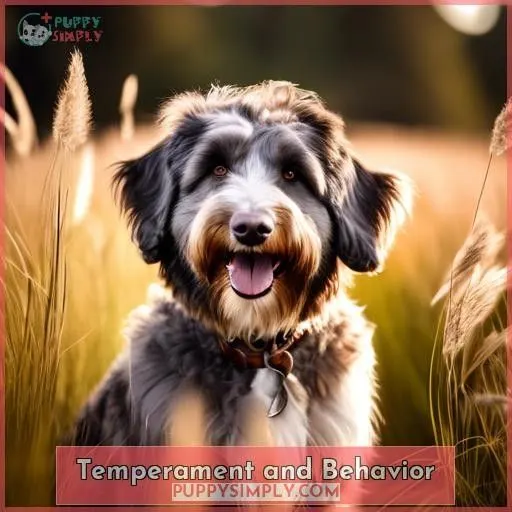This site is supported by our readers. We may earn a commission, at no cost to you, if you purchase through links.
The full-grown Aussiedoodle is an energetic and intelligent crossbreed that comes in three sizes – standard, miniature, and toy. As a hybrid of the Australian Shepherd and Poodle, they inherit a range of desirable traits like herding instincts, hypoallergenic coats, and trainability.
Aussiedoodles are loyal companions that require ample exercise and mental stimulation to thrive. While prone to certain health conditions like hip dysplasia, regular veterinary care can help manage these concerns.
Whether you’re drawn to the standard’s active nature, the miniature’s adaptability, or the toy’s lively personality, the full-grown Aussiedoodle offers a unique and rewarding pet experience.
Table Of Contents
Key Takeaways
- Full-grown Aussiedoodles come in three sizes: standard, miniature, and toy.
- They inherit traits from both parent breeds, including herding instincts, hypoallergenic coats, and trainability.
- Aussiedoodles require ample exercise and mental stimulation to thrive and can be prone to certain health conditions like hip dysplasia.
- They are loyal companions that offer a unique and rewarding pet experience.
Understanding the Aussiedoodle
The Aussiedoodle is a crossbreed between an Australian Shepherd and a Poodle. This hybrid breed is known for its fluffy, charismatic appearance and comes in three sizes: Standard, Miniature, and Toy.
The Aussiedoodle’s coat can be black, blue merle, or a combination of colors, and it’s light-shedding but not hypoallergenic. The breed has an average lifespan of 10-14 years and is known for its intelligence, trainability, and energy levels.
The Aussiedoodle requires daily playtime and long walks, enjoys fetch, running, and swimming, and needs at least an hour of exercise per day. Regular grooming is essential, and the breed can inherit health issues from both parent breeds, such as thyroid disease (from the Australian Shepherd) and sebaceous adenitis (from the Poodle).
Hip dysplasia and elbow dysplasia are also common in medium and large dog breeds, including Aussiedoodles. Bloat is a risk for large, deep-chested breeds.
Breed Origins
As a mix of the Australian Shepherd and Poodle, the full-grown Aussiedoodle inherits key traits from both parent breeds. You’ll see the herding instinct and energy of the Australian Shepherd combined with the intelligence and trainability of the Poodle.
Australian Shepherd Traits
As a cross between an Australian Shepherd and a Poodle, the Aussiedoodle inherits several traits from its parent breeds. Here are three key Australian Shepherd traits to keep in mind:
- Herding instincts: Aussiedoodles may have a strong desire to herd, which can manifest as chasing or nipping at people or other animals.
- Sensitivity: These dogs are known for their sensitivity, which can make them excellent companions but also require gentle handling.
- Loyalty and adaptability: Aussiedoodles are loyal and adaptable, making them great companions for various lifestyles and living environments.
These traits, along with their size, color, and potential health issues, contribute to the unique characteristics of the Aussiedoodle.
Poodle Traits
Poodles are known for their hypoallergenic nature and their coat colors, which range from solid colors like black, blue, brown, cafe au lait, cream, gray, red, and apricot, to patterns like parti, which can include a wide array of colors as the coat clears during the first 2 years.
They’re light shedders, but their hair growth and shedding pattern are different from many other breeds, making it appear as though they don’t shed at all.
Poodles are also intelligent, with a high level of problem-solving and emotional intelligence, making them highly trainable and suitable for families. They’re often used as retrievers due to their water-loving nature and their ability to excel in this role.
Poodles require regular grooming to prevent matting and tangling, which can be uncomfortable and lead to skin issues.
Size and Appearance
As an Aussiedoodle owner, you’ll find these dogs come in a variety of size categories. From the Standard Aussiedoodle to the compact Miniature and petite Toy varieties, each size offers unique characteristics and care considerations.
Standard Aussiedoodle
As a full-grown Standard Aussiedoodle, you’ll find yourself with a loyal companion that’s both active and intelligent. These dogs are light shedders, but they’re not hypoallergenic, so potential allergies should be considered.
Comparatively larger than a Miniature Aussiedoodle, you’ll need a spacious yard for exercise and playtime. Temperament variations can include toughness, energy, and trainability, with some health risks like bloat and hip dysplasia.
Keep them active and engaged to prevent boredom and destructive behavior.
Miniature Aussiedoodle
Welcome to the realm of the Miniature Aussiedoodle! This enchanting hybrid is a harmonious blend of the Australian Shepherd and Poodle, renowned for its velvety coat, affable nature, and adaptability. Let’s delve into the intricacies of this breed, discerning its size, appearance, and indispensable care.
In terms of size, Miniature Aussiedoodles typically weigh between 15 and 35 pounds, categorizing them as medium-sized dogs. Their adaptability allows them to flourish in diverse living arrangements, including apartments, provided their need for exercise is met. Their stature makes them suitable for families with limited space, albeit it’s imperative to note that they still require ample exercise to curb their energetic disposition.
Regarding appearance, Miniature Aussiedoodles exhibit a spectrum of colors, encompassing black, blue merle, and various merle hues. They may inherit the Poodle’s ringleted coat or the Australian Shepherd’s straight coat, and although not hypoallergenic, their curly coats shed less and generate minimal dander, potentially alleviating allergies.
When it comes to essential care, Miniature Aussiedoodles are intelligent and highly trainable canines that demand daily playtime and extended walks. They revel in activities such as retrieving, sprinting, and aquatic frolics, and require at least an hour of exercise daily to maintain their well-being. Regular grooming is vital to preserving their coats’ pristine condition, and they may necessitate seasonal professional or at-home trims.
While Miniature Aussiedoodles generally enjoy good health, they may be susceptible to ailments prevalent in both parent breeds, such as hip dysplasia and thyroid dysfunction. It’s paramount to schedule routine veterinary examinations and provide a balanced diet to safeguard their long-term well-being.
Toy Aussiedoodle
As a Toy Aussiedoodle, your dog is a delightful companion, weighing between 6-15 pounds and standing at 10-12 inches tall. Known for their curly hair and hypoallergenic qualities, they’re an ideal choice for older adults and those with allergies.
With a lifespan of 10-14 years, these dogs are energetic and intelligent, requiring daily playtime and long walks. Regular grooming is essential to maintain their coat, and they’re generally low-shedders.
However, be cautious about chocolate toxicity, as even a small amount can cause severe symptoms.
Temperament and Behavior
As an Aussiedoodle owner, you’ll appreciate your pup’s intelligence and trainability. These dogs are high-energy and playful, so be prepared to provide ample exercise and mental stimulation to keep them happy and well-behaved.
Intelligence and Trainability
As a fully mature Aussiedoodle, you’ll discover that this breed isn’t merely cute but also exceptionally intelligent and trainable. With a blend of Australian Shepherd and Poodle characteristics, your Aussiedoodle is likely to flourish in obedience training, trick acquisition, and puppy classes.
Clicker training is also a prevalent approach for teaching commands and tricks. Socialization classes are indispensable for your Aussiedoodle’s growth, as they assist your dog in becoming well-rounded and versatile.
Despite being a minimal shedder, your Aussiedoodle may still encounter food or environmental allergies, therefore regular grooming is essential.
Energy Levels and Playfulness
Your Aussiedoodle will be a lively companion. As a cross between the Australian Shepherd and Poodle, they inherit a natural curiosity and loyalty from the Australian Shepherd, and the Poodle’s agility and trainability.
They excel at activities like swimming, agility courses, lure chasing, therapy work, and dock jumping. Their energy levels vary depending on their size and individual traits.
Socialization and obedience training are essential to channel their energy and prevent destructive behavior.
Health Considerations
As a full-grown Aussiedoodle owner, you’ll want to be aware of the breed’s potential health concerns. While they’re generally healthy, Aussiedoodles can be prone to genetic conditions like thyroid disease and sebaceous adenitis, as well as orthopedic issues like hip and elbow dysplasia. Careful monitoring and preventative care can help mitigate these risks.
Genetic Conditions
As a responsible Aussiedoodle owner, it’s essential to be cognizant of the genetic conditions that your furry friend may inherit from their parent breeds. Thyroid disease is a prevalent condition in Australian Shepherds, while sebaceous adenitis is common in Poodles.
Hip dysplasia and elbow dysplasia are also potential health concerns for Aussiedoodles. To safeguard the well-being of your Aussiedoodle, consider breed-specific insurance and partake in preventative measures such as health screening and routine veterinary check-ups.
By being proactive, you can assist your Aussiedoodle in living a long, healthy, and fulfilling life.
Hip and Elbow Dysplasia
Hip and elbow dysplasia are widespread joint problems in dogs, including the Aussiedoodle. These conditions are inherited from the parent breeds, with the Australian Shepherd contributing to hip dysplasia and the Poodle contributing to elbow dysplasia. Understanding the particulars of these conditions can help you provide the best care for your Aussiedoodle.
Hip Dysplasia
- Hip Score: This is a measure of the degree of hip joint laxity, with higher scores indicating a greater risk of developing hip dysplasia.
- Elbow Score: Similar to the hip score, this measures the laxity of the elbow joint and can indicate the likelihood of elbow dysplasia.
- Diagnosis Methods: Radiography is the primary method for detecting hip dysplasia, while elbow dysplasia may require more advanced imaging techniques like CT or arthroscopy.
- Treatment Options: Treatment for hip dysplasia can range from conservative management to surgery, depending on the severity of the condition.
Elbow Dysplasia
- Prognosis Factors: The prognosis for elbow dysplasia depends on the specific condition and the age at which it’s diagnosed. Early diagnosis and prompt treatment are essential for the best outcomes.
- Treatment Options: Treatment for elbow dysplasia can include medical management, surgery, or a combination of both.
While both hip and elbow dysplasia can lead to osteoarthritis, the specific symptoms and treatment options may vary depending on the affected joint. It’s imperative to work closely with your veterinarian to develop a comprehensive care plan for your Aussiedoodle, taking into account their size, breed, and individual needs.
Bloat Risks
Regarding your Aussiedoodle, bloat prevention is crucial. These deep-chested breeds are susceptible to gastric dilation, a severe condition. Steer clear of elevated feeding bowls and excessive feeding by adhering to predetermined meal portions.
In addition to joint dysplasia, bloat poses a significant health concern that warrants attention.
Bear in mind that a well-balanced diet fortified with vitamin D3 contributes to overall well-being, encompassing skin and ear care.
Grooming and Care
As a full-grown Aussiedoodle, you’ll need to stay on top of its grooming needs. Expect to brush its thick, wavy coat regularly and schedule professional grooming sessions every 6-8 weeks to keep its appearance neat and tidy.
Exercise Needs
To guarantee your Aussiedoodle’s well-being, contentment, and obedience, it’s imperative to supply them with the requisite amount of exercise. Here are some pointers to assist you in comprehending your Aussiedoodle’s exercise necessities:
- Exercise Frequency: Aussiedoodles necessitate at minimum one hour of exercise daily, with more for energetic types. For mature Aussiedoodles, two hours of daily exercise is suggested.
- Indoor Play Options: In the absence of a yard, furnish indoor playtime with toys, obstacle courses, and training exercises.
- Weather Considerations: Aussiedoodles are fond of outdoor activities, but be aware of extreme weather conditions. Modify their exercise routine correspondingly.
- Leash Training: Instruct your Aussiedoodle to ambulate on a leash, which will aid in managing their energy and preserving their safety during walks.
- Enrichment Games: Engage your Aussiedoodle in interactive games such as hide and seek, frisbee fetch, and off-leash training to impart mental stimulation and exhaust them.
- Eye Care: Routine eye examinations are paramount for Aussiedoodles, as they’re susceptible to eye ailments due to their genetic makeup.
- Field Events: Participate in dog-friendly events like agility courses, which impart physical and mental stimulation for your Aussiedoodle.
- Flea Allergy Dermatitis: Maintain the cleanliness of your Aussiedoodle’s environment to avert flea infestations, which can induce skin irritation and allergic reactions.
Grooming Routine
Grooming is an essential aspect of an Aussiedoodle’s care, as their unique coat requires regular maintenance to prevent tangling and maintain overall health. Here’s a guide on how to groom your Aussiedoodle effectively:
- Brushing: Brush your Aussiedoodle at least 2-3 times a week, and daily during shedding seasons. Use a slicker brush for curly and wavy coats, and a different approach for straight coats. Brushing helps distribute natural oils, keeps the coat clean, and prevents matting.
- Bathing: Bathe your Aussiedoodle every 4-6 weeks or as needed, using a dog-specific shampoo and conditioner. Overbathing can strip natural oils from their skin, so be careful not to bathe too frequently.
- Ear and Eye Care: Regularly check and clean your Aussiedoodle’s ears, especially for those with long, floppy ears. Trim the fur around their eyes to ensure clear vision and prevent eye issues.
- Professional Grooming: While regular home grooming is essential, don’t underestimate the value of professional grooming services. They can expertly handle deep matting, style the coat beautifully, and provide advice specific to your dog’s needs.
- Health Benefits: Grooming is more than just aesthetics. It’s an opportunity to check for skin issues, parasites, and unusual lumps. Regular check-ins keep your Aussiedoodle looking their best and staying healthy.
Feeding and Nutrition
As an active and energetic breed, Aussiedoodles require a balanced diet to meet their nutritional needs. Be mindful not to overfeed your Aussiedoodle, as it can lead to weight gain and other health issues.
Diet for Active Dogs
To guarantee your Aussiedoodle’s health and vitality, adhere to dietary guidelines tailored to their mixed heritage. Portion regulation is crucial, as is providing AAFCO-approved sustenance.
Young pups require specific nutritional support, whereas mature dogs should transition to adult dog food post their first birthday. Vitamin A inadequacy can result in Addison’s disease, so maintain a balanced and diverse diet.
Food sensitivities are prevalent, so observe their responses and modify accordingly.
Avoiding Overfeeding
To avoid overfeeding your Aussiedoodle, follow these guidelines:
- Portion size: Feed your Aussiedoodle the recommended amount based on their size, age, and overall health. The dog food packaging will provide guidance, but consult with your veterinarian for personalized advice.
- Feeding frequency: Feed your Aussiedoodle two meals a day, while puppies may need three to four meals daily on a consistent schedule.
- Raised bowls: Avoid using raised dog bowls to minimize the risk of bloat. Instead, use a slow-feeder bowl that makes it difficult for your dog to consume large bites quickly.
- Exercise around mealtimes: Exercise your Aussiedoodle before or after meals to reduce the risk of bloat.
Training and Socialization
Proper training and socialization are essential for your full-grown Aussiedoodle. Early exposure to various environments and people will help prevent destructive behaviors and guarantee your Aussiedoodle becomes a well-adjusted, obedient companion.
Importance of Early Training
Early training is essential for your Aussiedoodle’s growth. Commence socializing your puppy from a tender age to assist them in becoming well-balanced and self-assured dogs. Set limits with positive reinforcement, offering mental stimulation through training and socialization sessions. Bear in mind, a well-trained Aussiedoodle is a contented, healthy, and well-behaved companion.
Preventing Destructive Behavior
The Aussiedoodle breed is renowned for its astuteness and amenability to training. However, they may grow disruptive if not granted sufficient cerebral invigoration and bodily exertion.
To avert destructive habits, prioritize particular instruction and positive reinforcement. Additionally, provide engaging playthings.
Allot at least sixty minutes of exercise daily and ensure they receive the appropriate amount of mental stimulation relevant to their breed-specific requirements.
A thoroughly exercised and stimulated Aussiedoodle is a contented and well-mannered one.
Living With an Aussiedoodle
The Aussiedoodle’s adaptable nature makes them suitable for a variety of living environments, from families with children to seniors looking for an energetic companion. Whether you have a spacious yard or a cozy apartment, an Aussiedoodle can thrive as long as their exercise and mental stimulation needs are met.
Family Compatibility
Living with an Aussiedoodle can be a delightful experience for families. Here’s how to make sure it’s a perfect fit:
- Apartment Living: Aussiedoodles need space for exercise. A yard is ideal, but they can adapt to apartment life with daily walks.
- Senior Suitability: Toy Aussiedoodles are a great choice for older adults, as they’re smaller and less active.
- First-time Owners: Aussiedoodles are trainable and intelligent, making them suitable for first-time owners.
- Exercise Requirements: Standard Aussiedoodles need lots of exercise, while Miniature and Toy breeds require less. Make sure they meet their exercise needs to prevent boredom and destructive behavior.
Adapting to Various Living Environments
Adjusting to different living situations is essential for your Aussiedoodle’s health. In the city, your Aussiedoodle might need to adapt to loud sounds and bustling streets. Rural living provides more space and chances for outdoor activities.
For apartment living, make sure your dog receives ample exercise and mental stimulation.
As a senior companion, your Aussiedoodle may require more rest and less exercise.
Aussiedoodles with special needs might need additional arrangements, such as ramps or specialized diets.
Frequently Asked Questions (FAQs)
What is the ideal age for an Aussiedoodle to be fully grown?
You’ll find your Aussiedoodle is usually fully grown by their 1st birthday. They mature quickly, so be ready to provide ample exercise and training from a young age to keep them happy and healthy.
How often should an Aussiedoodle be bathed?
Bathe your fluffy Aussiedoodle pal every 4-6 weeks to keep that coat looking sharp. Rub-a-dub-dub, let the suds fly and watch them shimmer like freshly fallen snow. A clean pup is a happy pup!
Can Aussiedoodles be left alone for long periods of time?
Aussiedoodles don’t take well to long periods alone. They’re highly social and need regular exercise and interaction. Leaving them for hours on end can lead to destructive behavior and unhappiness. Give your Aussiedoodle plenty of attention and engagement.
What is the recommended exercise routine for an Aussiedoodle?
Your Aussiedoodle needs daily exercise to stay healthy and happy – think long walks, vigorous playtime, and mentally stimulating activities like agility training. Stay on top of their fitness, and they’ll thrive.
How can I prevent my Aussiedoodle from developing bad habits?
An Aussiedoodle’s intelligence means you must provide 60 minutes of daily exercise to curb boredom – otherwise, they’ll chew up your house! Engage their mind through training and mentally stimulating activities to prevent destructive behaviors.
Conclusion
Certainly, the mature Aussiedoodle is the crowning jewel in the quest for the ideal canine companion. With their boundless enthusiasm and amiable disposition, these charming crossbreeds are a veritable delight to call your own.
Regardless of your preference for the standard, miniature, or toy size, the adult Aussiedoodle guarantees a fulfilling pet ownership experience that will elicit exuberant tail wags from you.
The versatility of Aussiedoodles to thrive in diverse living arrangements further enhances their appeal as a cherished companion.
















